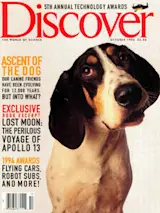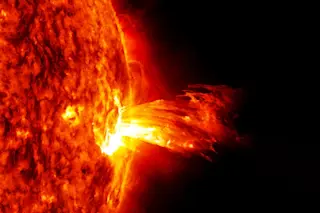A dark but fascinating drama unfolds like a Greek tragedy this month. Though autumn foliage gamely provides a last splash of brilliant color, Nature’s decree is scrawled everywhere: our Northern Hemisphere is darkening.
As if mirroring the situation below, the sky, too, retreats from the brilliant summer stars to the year’s dimmest panorama. Midnight sky watchers find their eyes directed beyond the galaxy toward the yawning blackness of the intergalactic void. Autumn constellations are the year’s only patterns that cannot boast a single first-magnitude star, making this a good time to stalk galaxies--like the great Andromeda now overhead.
At midnight, the last bright summer stars topple into the west while the gleaming harbingers of winter make their dramatic debut in the east. In between, the night is a murky wall, with just the lonely planet Saturn providing a dash of zip in the south. You can improve this gloomy situation by venturing out early, at nightfall. That’s when the Milky Way splits the sky like a torn stocking, running wildly from north to south in the year’s best presentation of our own galaxy.
From rural settings, where the sky shows its best stuff, complex dark patches mottle the Milky Way. Nearly overhead the shadowy intrusions grow so wide that the Milky Way appears to be split in two--wedged apart by the Great Rift. Language struggles to express the immensity of these dusty gas clouds sandwiched between the individual stars of the night and the dreamy background glow.
This blackness is illuminating. Examined with the naked eye, but especially with binoculars, its ragged edges highlight the dusty gas of our galaxy’s nearest spiral arm. Spectrographs have found a smorgasbord of more than 100 molecules here, including such complex organic substances as ethyl alcohol. The largest black clouds contain enough to make 1028 bottles of liquor--ten octillion fifths.
But wild parties in Sagittarius are just the beginning. The raven clouds of night contain acetaldehyde and cyanoacetylene, precursors of the amino acids so basic to life. Did the seeds of life originate among the stars? Earlier this year two University of Illinois researchers reported finding strong evidence for the existence of an amino acid--glycine--in interstellar clouds near the galaxy’s center. If the research holds up, it will be the first time one of the amino acids so essential to life on Earth has been detected outside the solar system. (Some have been found in meteorites and moon rocks.)
Nearly straight overhead, just where the Great Rift begins, flies Cygnus the Swan. The star Eta marks the middle of its long neck, and one moon’s width to Eta’s northeast lies the sky’s surest black hole, Cygnus X- 1. It’s orbited by a ninth-magnitude star, barely visible with binoculars, that goes by the catchy name of HDE226868.
Star stuff shed by HDE226868 spirals inexorably into the black hole at such high speeds that it emits final X-ray yelps as if in protest. You can’t see any of it, but what did you expect from invisible light coming out of a black hole that itself sits on the edge of a great black rift?
No, if it’s brilliance you want, rise before dawn or else observe just after dusk. But if you like to stargaze during the normal premidnight hours, this October’s theme song is Paint It Black.














